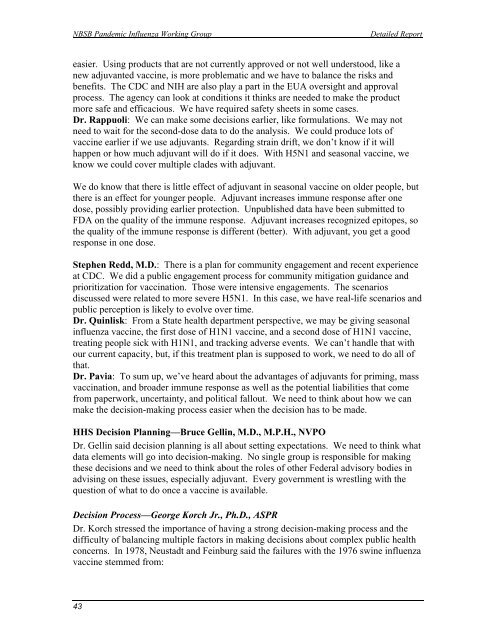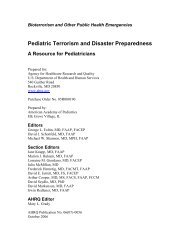H1N1 COUNTERMEASURES STRATEGY AND ... - PHE Home
H1N1 COUNTERMEASURES STRATEGY AND ... - PHE Home
H1N1 COUNTERMEASURES STRATEGY AND ... - PHE Home
Create successful ePaper yourself
Turn your PDF publications into a flip-book with our unique Google optimized e-Paper software.
NBSB Pandemic Influenza Working Group<br />
Detailed Report<br />
easier. Using products that are not currently approved or not well understood, like a<br />
new adjuvanted vaccine, is more problematic and we have to balance the risks and<br />
benefits. The CDC and NIH are also play a part in the EUA oversight and approval<br />
process. The agency can look at conditions it thinks are needed to make the product<br />
more safe and efficacious. We have required safety sheets in some cases.<br />
Dr. Rappuoli: We can make some decisions earlier, like formulations. We may not<br />
need to wait for the second-dose data to do the analysis. We could produce lots of<br />
vaccine earlier if we use adjuvants. Regarding strain drift, we don’t know if it will<br />
happen or how much adjuvant will do if it does. With H5N1 and seasonal vaccine, we<br />
know we could cover multiple clades with adjuvant.<br />
We do know that there is little effect of adjuvant in seasonal vaccine on older people, but<br />
there is an effect for younger people. Adjuvant increases immune response after one<br />
dose, possibly providing earlier protection. Unpublished data have been submitted to<br />
FDA on the quality of the immune response. Adjuvant increases recognized epitopes, so<br />
the quality of the immune response is different (better). With adjuvant, you get a good<br />
response in one dose.<br />
Stephen Redd, M.D.: There is a plan for community engagement and recent experience<br />
at CDC. We did a public engagement process for community mitigation guidance and<br />
prioritization for vaccination. Those were intensive engagements. The scenarios<br />
discussed were related to more severe H5N1. In this case, we have real-life scenarios and<br />
public perception is likely to evolve over time.<br />
Dr. Quinlisk: From a State health department perspective, we may be giving seasonal<br />
influenza vaccine, the first dose of <strong>H1N1</strong> vaccine, and a second dose of <strong>H1N1</strong> vaccine,<br />
treating people sick with <strong>H1N1</strong>, and tracking adverse events. We can’t handle that with<br />
our current capacity, but, if this treatment plan is supposed to work, we need to do all of<br />
that.<br />
Dr. Pavia: To sum up, we’ve heard about the advantages of adjuvants for priming, mass<br />
vaccination, and broader immune response as well as the potential liabilities that come<br />
from paperwork, uncertainty, and political fallout. We need to think about how we can<br />
make the decision-making process easier when the decision has to be made.<br />
HHS Decision Planning—Bruce Gellin, M.D., M.P.H., NVPO<br />
Dr. Gellin said decision planning is all about setting expectations. We need to think what<br />
data elements will go into decision-making. No single group is responsible for making<br />
these decisions and we need to think about the roles of other Federal advisory bodies in<br />
advising on these issues, especially adjuvant. Every government is wrestling with the<br />
question of what to do once a vaccine is available.<br />
Decision Process—George Korch Jr., Ph.D., ASPR<br />
Dr. Korch stressed the importance of having a strong decision-making process and the<br />
difficulty of balancing multiple factors in making decisions about complex public health<br />
concerns. In 1978, Neustadt and Feinburg said the failures with the 1976 swine influenza<br />
vaccine stemmed from:<br />
43
















